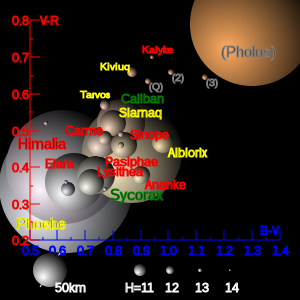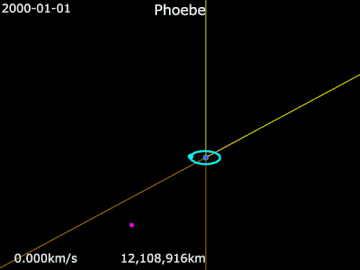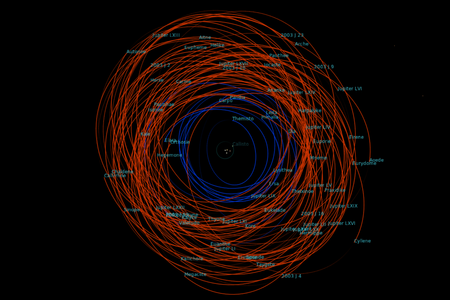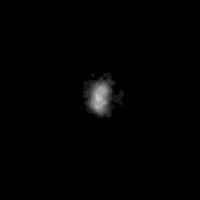
Nereid, or Neptune II, is the third-largest moon of Neptune. It has the most eccentric orbit of all known moons in the Solar System. It was the second moon of Neptune to be discovered, by Gerard Kuiper in 1949.

A natural satellite is, in the most common usage, an astronomical body that orbits a planet, dwarf planet, or small Solar System body. Natural satellites are colloquially referred to as moons, a derivation from the Moon of Earth.
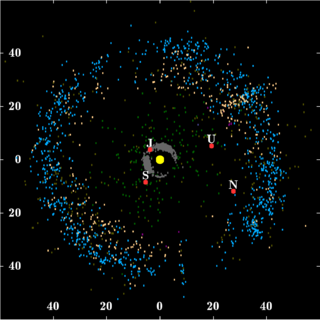
In planetary astronomy, a centaur is a small Solar System body that orbits the Sun between Jupiter and Neptune and crosses the orbits of one or more of the giant planets. Centaurs generally have unstable orbits because they cross or have crossed the orbits of the giant planets; almost all their orbits have dynamic lifetimes of only a few million years, but there is one known centaur, 514107 Kaʻepaokaʻawela, which may be in a stable orbit. Centaurs typically exhibit the characteristics of both asteroids and comets. They are named after the mythological centaurs that were a mixture of horse and human. Observational bias toward large objects makes determination of the total centaur population difficult. Estimates for the number of centaurs in the Solar System more than 1 km in diameter range from as low as 44,000 to more than 10,000,000.

Caliban is the second-largest retrograde irregular satellite of Uranus. It was discovered on 6 September 1997 by Brett J. Gladman, Philip D. Nicholson, Joseph A. Burns, and John J. Kavelaars using the 200-inch Hale telescope together with Sycorax and given the temporary designation S/1997 U 1.

Himalia, or Jupiter VI, is the largest irregular satellite of Jupiter, with a diameter of at least 140 km (90 mi). It is the sixth largest Jovian satellite, after the four Galilean moons and Amalthea. It was discovered by Charles Dillon Perrine at the Lick Observatory on 3 December 1904 and is named after the nymph Himalia, who bore three sons of Zeus. It is one of the largest planetary moons in the Solar System not imaged in detail, and the third largest not imaged in detail within the orbit of Neptune.

Pasiphae, formerly spelled Pasiphaë, is a retrograde irregular satellite of Jupiter. It was discovered in 1908 by Philibert Jacques Melotte and later named after the mythological Pasiphaë, wife of Minos and mother of the Minotaur from Greek legend.

Sycorax is the largest irregular satellite of Uranus. Sycorax was discovered on 6 September 1997 by Brett J. Gladman, Philip D. Nicholson, Joseph A. Burns, and John J. Kavelaars using the 200-inch Hale telescope, together with Caliban, and given the temporary designation S/1997 U 2.

There are 95 moons of Jupiter with confirmed orbits as of 5 February 2024. This number does not include a number of meter-sized moonlets thought to be shed from the inner moons, nor hundreds of possible kilometer-sized outer irregular moons that were only briefly captured by telescopes. All together, Jupiter's moons form a satellite system called the Jovian system. The most massive of the moons are the four Galilean moons: Io, Europa, Ganymede, and Callisto, which were independently discovered in 1610 by Galileo Galilei and Simon Marius and were the first objects found to orbit a body that was neither Earth nor the Sun. Much more recently, beginning in 1892, dozens of far smaller Jovian moons have been detected and have received the names of lovers or daughters of the Roman god Jupiter or his Greek equivalent Zeus. The Galilean moons are by far the largest and most massive objects to orbit Jupiter, with the remaining 91 known moons and the rings together composing just 0.003% of the total orbiting mass.

The moons of Saturn are numerous and diverse, ranging from tiny moonlets only tens of meters across to the enormous Titan, which is larger than the planet Mercury. There are 146 moons with confirmed orbits, the most of any planet in the solar system. This number does not include the many thousands of moonlets embedded within Saturn's dense rings, nor hundreds of possible kilometer-sized distant moons that were seen through telescopes but not recaptured. Seven Saturnian moons are large enough to have collapsed into a relaxed, ellipsoidal shape, though only one or two of those, Titan and possibly Rhea, are currently in hydrostatic equilibrium. Three moons are particularly notable. Titan is the second-largest moon in the Solar System, with a nitrogen-rich Earth-like atmosphere and a landscape featuring river networks and hydrocarbon lakes. Enceladus emits jets of ice from its south-polar region and is covered in a deep layer of snow. Iapetus has contrasting black and white hemispheres as well as an extensive ridge of equatorial mountains among the tallest in the solar system.

Skathi, also named Saturn XXVII and originally spelled Skadi, is a natural satellite of the planet Saturn. Skathi is one of Saturn's irregular moons, in its Norse group of satellites. It was discovered on September 23, 2000, by a team of astronomers led by Brett Gladman. The team announced their discovery on December 7, 2000, along with seven other satellites of Saturn, namely; Tarvos, Ijiraq, Thrymr, Siarnaq, Mundilfari, Erriapus, and Suttungr. The moon was named after Skaði, a figure in Norse mythology, as part of an effort to diversify the largely Greek and Roman names of astronomical objects.

Uranus, the seventh planet of the Solar System, has 28 known moons. Most of them are named after characters that appear in, or are mentioned in, the works of William Shakespeare and Alexander Pope. Uranus's moons are divided into three groups: thirteen inner moons, five major moons, and ten irregular moons. The inner and major moons all have prograde orbits and are cumulatively classified as regular moons. In contrast, the orbits of the irregular moons are distant, highly inclined, and mostly retrograde.

The planet Neptune has 16 known moons, which are named for minor water deities and a water creature in Greek mythology. By far the largest of them is Triton, discovered by William Lassell on October 10, 1846, 17 days after the discovery of Neptune itself. Over a century passed before the discovery of the second natural satellite, Nereid, in 1949, and another 40 years passed before Proteus, Neptune's second largest moon, was discovered in 1989.
The naming of moons has been the responsibility of the International Astronomical Union's committee for Planetary System Nomenclature since 1973. That committee is known today as the Working Group for Planetary System Nomenclature (WGPSN).
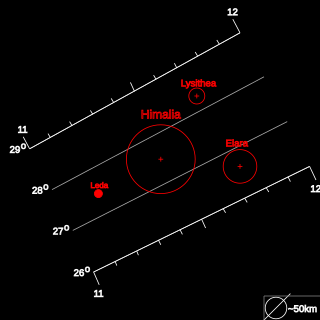
The Himalia group is a group of prograde irregular satellites of Jupiter that follow similar orbits to Himalia and are thought to have a common origin.
In astronomy, an inner moon or inner natural satellite is a natural satellite following a prograde, low-inclination orbit inwards of the large satellites of the parent planet. They are generally thought to have been formed in situ at the same time as the coalescence of the original planet. Neptune's moons are an exception, as they are likely reaggregates of the pieces of the original bodies, which were disrupted after the capture of the large moon Triton. Inner satellites are distinguished from other regular satellites by their proximity to the parent planet, their short orbital periods, their low mass, small size, and irregular shapes.

The Nicemodel is a scenario for the dynamical evolution of the Solar System. It is named for the location of the Côte d'Azur Observatory—where it was initially developed in 2005—in Nice, France. It proposes the migration of the giant planets from an initial compact configuration into their present positions, long after the dissipation of the initial protoplanetary disk. In this way, it differs from earlier models of the Solar System's formation. This planetary migration is used in dynamical simulations of the Solar System to explain historical events including the Late Heavy Bombardment of the inner Solar System, the formation of the Oort cloud, and the existence of populations of small Solar System bodies such as the Kuiper belt, the Neptune and Jupiter trojans, and the numerous resonant trans-Neptunian objects dominated by Neptune.

Retrograde motion in astronomy is, in general, orbital or rotational motion of an object in the direction opposite the rotation of its primary, that is, the central object. It may also describe other motions such as precession or nutation of an object's rotational axis. Prograde or direct motion is more normal motion in the same direction as the primary rotates. However, "retrograde" and "prograde" can also refer to an object other than the primary if so described. The direction of rotation is determined by an inertial frame of reference, such as distant fixed stars.
The jumping-Jupiter scenario specifies an evolution of giant-planet migration described by the Nice model, in which an ice giant is scattered inward by Saturn and outward by Jupiter, causing their semi-major axes to jump, and thereby quickly separating their orbits. The jumping-Jupiter scenario was proposed by Ramon Brasser, Alessandro Morbidelli, Rodney Gomes, Kleomenis Tsiganis, and Harold Levison after their studies revealed that the smooth divergent migration of Jupiter and Saturn resulted in an inner Solar System significantly different from the current Solar System. During this migration secular resonances swept through the inner Solar System exciting the orbits of the terrestrial planets and the asteroids, leaving the planets' orbits too eccentric, and the asteroid belt with too many high-inclination objects. The jumps in the semi-major axes of Jupiter and Saturn described in the jumping-Jupiter scenario can allow these resonances to quickly cross the inner Solar System without altering orbits excessively, although the terrestrial planets remain sensitive to its passage.

A satellite system is a set of gravitationally bound objects in orbit around a planetary mass object or minor planet, or its barycenter. Generally speaking, it is a set of natural satellites (moons), although such systems may also consist of bodies such as circumplanetary disks, ring systems, moonlets, minor-planet moons and artificial satellites any of which may themselves have satellite systems of their own. Some bodies also possess quasi-satellites that have orbits gravitationally influenced by their primary, but are generally not considered to be part of a satellite system. Satellite systems can have complex interactions including magnetic, tidal, atmospheric and orbital interactions such as orbital resonances and libration. Individually major satellite objects are designated in Roman numerals. Satellite systems are referred to either by the possessive adjectives of their primary, or less commonly by the name of their primary. Where only one satellite is known, or it is a binary with a common centre of gravity, it may be referred to using the hyphenated names of the primary and major satellite.
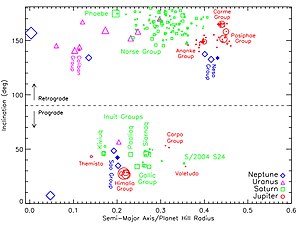

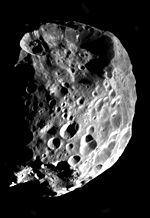
![The power law for the size distribution of objects in the Kuiper belt, where q [?] 4 and thus N ~ D . That is, for every Kuiper belt object of a particular size, there are approximately 8 times as many objects half that size and a thousands times as many objects one-tenth that size. TheKuiperBelt PowerLaw2.svg](http://upload.wikimedia.org/wikipedia/commons/thumb/f/fa/TheKuiperBelt_PowerLaw2.svg/220px-TheKuiperBelt_PowerLaw2.svg.png)



